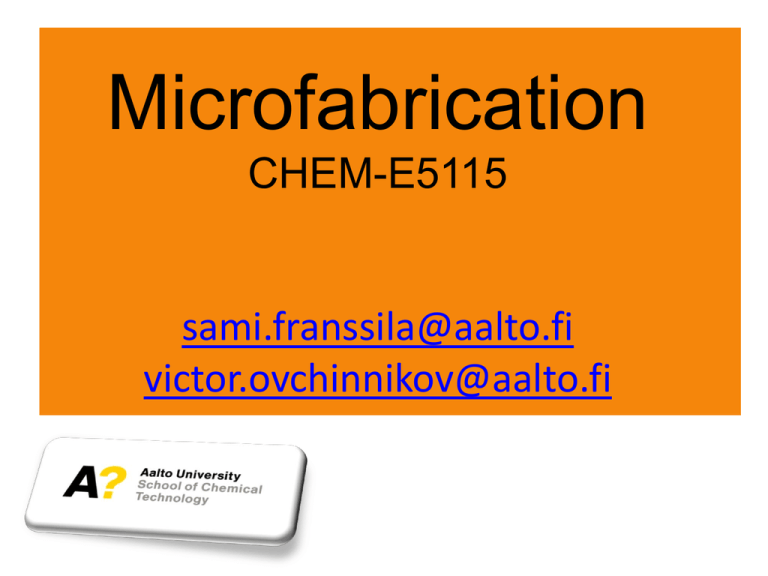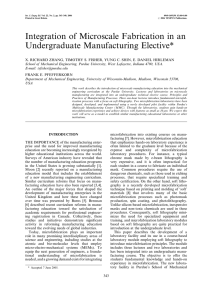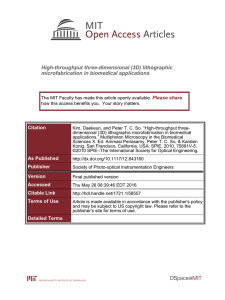spring term 2016
advertisement

Microfabrication CHEM-E5115 sami.franssila@aalto.fi victor.ovchinnikov@aalto.fi Goals After the course you should be able to design simple microfabrication processes and analyze complex processes. The devices look like these: You must understand: Microscale dimensions -is 4 nm film thickness possible ? -is 100 nm/min high or low rate? -is 300 MPa high or low stress ? -is 20 -cm resistivity OK for metal ? Materials -silicon wafers -thin films of SiO2, SiNx, Al, W, Cu, Au, Pt, …… Processing of materials at microscale: -patterning -doping -thin film deposition -bonding Learning Book -Introduction to Microfabrication -provides the facts Lectures -show how to think about the facts -show how to think with the facts -are no substitute for reading the book ! Exercises -develop feeling for orders of magnitude -check understanding of basic concepts -get acquainted with fabrication processes Lab demo -hands-on microfabrication The book Introduction to Microfabrication, 2nd edition (John Wiley, 2010) The course covers chapters 1-6, 9, 11-17, 20,21, 25-31, 35-38 (ca. 60% of the book). First edition 2004 can also be used. Available as e-book via Aalto library: http://lib.aalto.fi/en/ http://site.ebrary.com/lib/aalto/docDetail.action?docID=10419 414 Printed book from amazon (40£ used/50£ new + mail) Homework exercises Published on Tuesdays at 12 noon in Moodle Return to MyCourses by following Sunday 10 pm (22.00) pdf best format, MS Word also acceptable Late return box will be provided, but 1 point reduced Assistants will check and grade answers In Tuesday exercise session solutions are presented on board by the students (selected by the assistant from the best solutions) On-the-spot exercises Group work in groups of 3-4 persons 2 hour session (starts immediately after the lecture you have to read the related book chapters before the lecture !) 1 hour for group work and 1 hour for presentations Maximum 4 points, same for all group members Examples of exam questions • Compare optical lithography and electron beam lithography. • Explain step-by-step how the micro hot plate shown on top right was fabricated. • Explain step-by-step how the photodiode shown on the bottom right was fabricated. • The sensor is a wet etched silicon membrane device (20 µm membrane thickness). Membrane size is 1 mm*1 mm. How many good chips do you get from a 100 mm wafer? The cost of wafer processing is taken as 2 €/cm2 . How much does a single sensor cost if silicon chip cost is 30% of total sensor cost ? • Chemical-mechanical polishing. Exam cheat sheet You will have a 4-page cheat sheet about microfabrication available at the exam It contains most relevant facts Mistakes about facts that are in the cheat sheet will be aggressively graded Assessment Exam: 60 p: 6 questions, 5 must be answered (40% minimum required to pass) Homework exercises: 36 p. -(40% minimum required to pass) Group work: 24 points -(40% minimum required to pass) Total: 120 p. (considerable bonus possibility !) Tentative scale: Points 90-120 80-89 70-79 60-69 50-59 Grade 5 4 3 2 1 Related courses SPRING TERM 2016 ELEC-E3230 - Nanotechnology, 24.02.2016-31.03.2016 ELEC-E3210 - Optoelectronics, 07.01.2016-11.02.2016 ELEC-E3240 - Photonics, 12.04.2016-19.05.2016 CHEM-E5125 - Thin Film Technology, 24.02.2016-31.03.2016 CHEM-L2000 - Ultrathin Films, 22.02.2016-20.05.2016 CHEM-E8135 - Microfluidics and BioMEMS, 13.01.2016-11.05.2016 ELEC-E3220 - Semiconductor Devices, 04.01.2016-15.02.2016 FALL 2016 CHEM-E5225 Electron Microscopy PHYS-E0424 – Nanophysics CHEM-L2210 Thin Film Technology ELEC-E8713 Materials and microsystems integration







